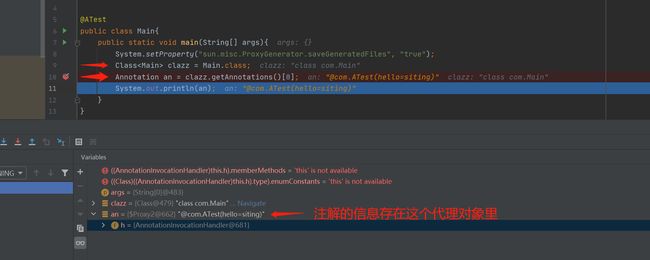基础篇:深入解析JAVA注解机制
目录标题
- java实现注解的底层原理和概念
- 五种元注解详解
- 使用动态代理机制处理注解
- spring.AOP和注解机制
- (题外)@FunctionalInterface原理介绍
-
- 欢迎指正文中错误
- 关注公众号,一起交流
- 参考文章
java实现注解的底层原理和概念
- java注解是JDK1.5引入的一种注释机制,java语言的类、方法、变量、参数和包都可以被注解标注。和Javadoc不同,java注解可以通过反射获取标注内容
- 在编译器生成.class文件时,注解可以被嵌入字节码中,而jvm也可以保留注解的内容,在运行时获取注解标注的内容信息
- java提供的注解可以分成两类:
作用在代码上的功能注解(部分):
| 注解名称 | 功能描述 |
|---|---|
| @Override | 检查该方法是否是重写方法。如果发现其父类,或者是引用的接口中并没有该方法时,会报编译错误 |
| @Deprecated | 标记过时方法。如果使用该方法,会报编译警告 |
| @SuppressWarnings | 指示编译器去忽略注释解中声明的警告 |
| @FunctionalInterface | java8支持,标识一个匿名函数或函数式接口 |
让给程序员开发自定义注解的元注解(和关键字@interface配合使用的注解)
| 元注解名称 | 功能描述 |
|---|---|
| @Retention | 标识这个注释解怎么保存,是只在代码中,还是编入类文件中,或者是在运行时可以通过反射访问 |
| @Documented | 标识这些注解是否包含在用户文档中 |
| @Target | 标识这个注解的作用范围 |
| @Inherited | 标识注解可被继承类获取 |
| @Repeatable | 标识某注解可以在同一个声明上使用多次 |
- Annotation是所有注解类的共同接口,不用显示实现。注解类使用@interface定义(代表它实现Annotation接口),搭配元注解使用,如下
package java.lang.annotation;
public interface Annotation {
boolean equals(Object obj);
int hashCode();
String toString();
// 返回定义的注解类型,你在代码声明的@XXX,相当于该类型的一实例
Class<? extends Annotation> annotationType();
}
-----自定义示例-----
@Retention( value = RetentionPolicy.RUNTIME)
@Target(value = ElementType.TYPE)
public @interface ATest {
String hello() default "siting";
}
ATest的字节码文件,编译器让自定义注解实现了Annotation接口
public abstract @interface com/ATest implements java/lang/annotation/Annotation {
// compiled from: ATest.java
@Ljava/lang/annotation/Retention;(value=Ljava/lang/annotation/RetentionPolicy;.RUNTIME)
@Ljava/lang/annotation/Target;(value={Ljava/lang/annotation/ElementType;.TYPE})
// access flags 0x401
public abstract hello()Ljava/lang/String;
default="siting"
}
- 自定义注解类型时,一般需要用@Retention指定注解保留范围RetentionPolicy,@Target指定使用范围ElementType。RetentionPolicy保留范围只能指定一个,ElementType使用范围可以指定多个
- 注解信息怎么和代码关联在一起,java所有事物都是类,注解也不例外,加入代码
System.setProperty("sum.misc.ProxyGenerator.saveGeneratedFiles","true");可生成注解相应的代理类

在代码里定义的注解,会被jvm利用反射技术生成一个代理类,然后和被注释的代码(类,方法,属性等)关联起来
五种元注解详解
- @Retention:指定注解信息保留阶段,有如下三种枚举选择。只能选其一
public enum RetentionPolicy {
/** 注解将被编译器丢弃,生成的class不包含注解信息 */
SOURCE,
/** 注解在class文件中可用,但会被JVM丢弃;当注解未定义Retention值时,默认值是CLASS */
CLASS,
/** 注解信息在运行期(JVM)保留(.class也有),可以通过反射机制读取注解的信息,
* 操作方法看AnnotatedElement(所有被注释类的父类) */
RUNTIME
}
- @Documented:作用是告诉JavaDoc工具,当前注解本身也要显示在Java Doc中(不常用)
- @Target:指定注解作用范围,可指定多个
public enum ElementType {
/** 适用范围:类、接口、注解类型,枚举类型enum */
TYPE,
/** 作用于类属性 (includes enum constants) */
FIELD,
/** 作用于方法 */
METHOD,
/** 作用于参数声明 */
PARAMETER,
/** 作用于构造函数声明 */
CONSTRUCTOR,
/** 作用于局部变量声明 */
LOCAL_VARIABLE,
/** 作用于注解声明 */
ANNOTATION_TYPE,
/** 作用于包声明 */
PACKAGE,
/** 作用于类型参数(泛型参数)声明 */
TYPE_PARAMETER,
/** 作用于使用类型的任意语句(不包括class) */
TYPE_USE
}
TYPE_PARAMETER的用法示例
class D<@PTest T> { } // 注解@PTest作用于泛型T
TYPE_USE的用法示例
//用于父类或者接口
class Test implements @Parent TestP {}
//用于构造函数
new @Test String("/usr/data")
//用于强制转换和instanceof检查,注意这些注解中用于外部工具
//它们不会对类型转换或者instanceof的检查行为带来任何影响
String path=(@Test String)input;
if(input instanceof @Test String) //注解不会影响
//用于指定异常
public Person read() throws @Test IOException.
//用于通配符绑定
List<@Test ? extends Data>
List<? extends @Test Data>
@Test String.class //非法,不能标注class
- @Inherited:表示当前注解会被注解类的子类继承。即在子类Class
通过getAnnotations()可获取父类被@Inherited修饰的注解。而注解本身是不支持继承
@Inherited
@Retention( value = RetentionPolicy.RUNTIME)
@Target(value = ElementType.TYPE)
public @interface ATest { }
----被ATest注解的父类PTest----
@ATest
public class PTest{ }
---Main是PTest的子类----
public class Main extends PTest {
public static void main(String[] args){
Annotation an = Main.class.getAnnotations()[0];
//Main可以拿到父类的注解ATest,因为ATest被元注解@Inherited修饰
System.out.println(an);
}
}
---result--
@com.ATest()
- @Repeatable:JDK1.8新加入的,表明自定义的注解可以在同一个位置重复使用。在没有该注解前,是无法在同一个类型上使用相同的注解多次
//Java8前无法重复使用注解
@FilterPath("/test/v2")
@FilterPath("/test/v1")
public class Test {}
使用动态代理机制处理注解
- 反射机制获取注解信息
--- 作用于注解的注解----
@Inherited
@Retention( value = RetentionPolicy.RUNTIME)
@Target(value = {ElementType.ANNOTATION_TYPE})
public @interface AnnotationTest {
String value() default "AnnotationTest";
}
------父类-------
public class PTest {}
------被注解修饰的package-info.java------
//package-info.java
@AnTest("com-package-info")
package com;
-------------
@AnnotationTest("AnnotationTest")
@Inherited
@Retention( value = RetentionPolicy.RUNTIME)
@Target(value = {ElementType.TYPE_USE,ElementType.PACKAGE,ElementType.FIELD,
ElementType.TYPE_PARAMETER,ElementType.CONSTRUCTOR,ElementType.LOCAL_VARIABLE})
public @interface AnTest {
String value() default "siting";
}
运行示例
//注解类
@AnTest("mainClass")
//注解泛型参数 //注解继承父类
public class Main<@AnTest("parameter") T > extends @AnTest("parent") PTest {
@AnTest("constructor") //注解构造函数
Main(){ }
//注解字段域
private @AnTest("name") String name;
//注解泛型字段域
private @AnTest("value") T value;
//注解通配符
private @AnTest("list")List<@AnTest("generic") ?>list;
//注解方法
@AnTest("method") //注解方法参数
public String hello(@AnTest("methodParameter") String name)
throws @AnTest("Exception") Exception { // 注解抛出异常
//注解局部变量,现在运行时暂时无法获取(忽略)
@AnTest("result") String result;
result = "siting";
System.out.println(name);
return result;
}
public static void main(String[] args) throws Exception {
Main<String> main = new Main<> ();
Class<Main<Object>> clazz = (Class<Main<Object>>) main.getClass();
//class的注解
Annotation[] annotations = clazz.getAnnotations();
AnTest testTmp = (AnTest) annotations[0];
System.out.println("修饰Main.class注解value: "+testTmp.value());
//构造器的注解
Constructor<Main<Object>> constructor = (Constructor<Main<Object>>) clazz.getDeclaredConstructors()[0];
testTmp = constructor.getAnnotation(AnTest.class);
System.out.println("修饰构造器的注解value: "+testTmp.value());
//继承父类的注解
AnnotatedType annotatedType = clazz.getAnnotatedSuperclass();
testTmp = annotatedType.getAnnotation(AnTest.class);
System.out.println("修饰继承父类的注解value: "+testTmp.value());
//注解的注解
AnnotationTest annotationTest = testTmp.annotationType().getAnnotation(AnnotationTest.class);
System.out.println("修饰注解的注解AnnotationTest-value: "+annotationTest.value());
//泛型参数 T 的注解
TypeVariable<Class<Main<Object>>> variable = clazz.getTypeParameters()[0];
testTmp = variable.getAnnotation(AnTest.class);
System.out.println("修饰泛型参数T注解value: "+testTmp.value());
//普通字段域 的注解
Field[] fields = clazz.getDeclaredFields();
Field nameField = fields[0];
testTmp = nameField.getAnnotation(AnTest.class);
System.out.println("修饰普通字段域name注解value: "+testTmp.value());
//泛型字段域 的注解
Field valueField = fields[1];
testTmp = valueField.getAnnotation(AnTest.class);
System.out.println("修饰泛型字段T注解value: "+testTmp.value());
//通配符字段域 的注解
Field listField = fields[2];
AnnotatedParameterizedType annotatedPType = (AnnotatedParameterizedType)listField.getAnnotatedType();
testTmp = annotatedPType.getAnnotation(AnTest.class);
System.out.println("修饰泛型注解value: "+testTmp.value());
//通配符注解 的注解
AnnotatedType[] annotatedTypes = annotatedPType.getAnnotatedActualTypeArguments();
AnnotatedWildcardType annotatedWildcardType = (AnnotatedWildcardType) annotatedTypes[0];
testTmp = annotatedWildcardType.getAnnotation(AnTest.class);
System.out.println("修饰通配符注解value: "+testTmp.value());
//方法的注解
Method method = clazz.getDeclaredMethod("hello", String.class);
annotatedType = method.getAnnotatedReturnType();
testTmp = annotatedType.getAnnotation(AnTest.class);
System.out.println("修饰方法的注解value: "+testTmp.value());
//异常的注解
annotatedTypes = method.getAnnotatedExceptionTypes();
testTmp = annotatedTypes[0].getAnnotation(AnTest.class);
System.out.println("修饰方法抛出错误的注解value: "+testTmp.value());
//方法参数的注解
annotatedTypes = method.getAnnotatedParameterTypes();
testTmp = annotatedTypes[0].getAnnotation(AnTest.class);
System.out.println("修饰方法参数注解value: "+testTmp.value());
//包的注解
Package p = Package.getPackage("com");
testTmp = p.getAnnotation(AnTest.class);
System.out.println("修饰package注解value: "+testTmp.value());
main.hello("hello");
}
}
结果
修饰Main.class注解value: mainClass
修饰构造器的注解value: constructor
修饰继承父类的注解value: parent
修饰注解的注解AnnotationTest-value: AnnotationTest
修饰泛型参数T注解value: parameter
修饰普通字段域name注解value: name
修饰泛型字段T注解value: value
修饰泛型注解value: list
修饰通配符注解value: generic
修饰方法的注解value: method
修饰方法抛出错误的注解value: Exception
修饰方法参数注解value: methodParameter
修饰package注解value: com-package-info
hello
spring.AOP和注解机制
spring.AOP相当于动态代理和注解机制在spring框架的结合实现
- 前要知识:面向切面编程(AOP)和动态代理
- C是面向过程编程的,java则是面向对象编程,C++则是两者兼备,它们都是一种规范和思想。面向切面编程也一样,可以简单理解为:切面编程专注的是局部代码,主要为某些点植入增强代码
- 考虑要局部加入增强代码,使用动态代理则是最好的实现。在被代理方法调用的前后,可以加入需要的增强功能;因此spring的切面编程是基于动态代理的
- 切面的概念
| 概念 | 描述 |
|---|---|
| 通知(Advice) | 需要切入的增强代码逻辑被称为通知 |
| 切点(Pointcut) | 定义增强代码在何处执行 |
| 切面(Aspect) | 切面是通知和切点的集合 |
| 连接点(JoinPoint) | 在切点基础上,指定增强代码在切点执行的时机(在切点前,切点后,抛出异常后等) |
| 目标(target) | 被增强目标类 |
- spring.aop提供的切面注解
| 切面编程相关注解 | 功能描述 |
|---|---|
| @Aspect | 作用于类,声明当前方法类是增强代码的切面类 |
| @Pointcut | 作用于方法,指定需要被拦截的其他方法。当前方法则作为拦截集合名使用 |
- spring的通知注解其实是通知+指定连接点组成,分五种(Before、After、After-returning、After-throwing、Around)
| spring通知(Advice)注解 | 功能描述 |
|---|---|
| @After | 增强代码在@Pointcut指定的方法之后执行 |
| @Before | 增强代码在@Pointcut指定的方法之前执行 |
| @AfterReturning | 增强代码在@Pointcut指定的方法 return返回之后执行 |
| @Around | 增强代码可以在被拦截方法前后执行 |
| @AfterThrowing | 增强代码在@Pointcut指定的方法抛出异常之后执行 |
- 在spring切面基础上,开发具有增强功能的自定义注解 (对注解进行切面)
新建spring-web + aop 项目;新建如下class
------ 目标Controller ------
@RestController
public class TestController {
@STAnnotation
@RequestMapping("/hello")
public String hello(){ return "hello@csc"; }
}
------ Controller注解 -------
@Retention( value = RetentionPolicy.RUNTIME)
@Target(value = ElementType.METHOD)
public @interface STAnnotation {
String value() default "注解hello!";
}
------ Controller切面 ------
@Aspect
@Component
public class ControllerAspect {
//切点:注解指定关联 (对注解进行切面)
@Pointcut("@annotation(STAnnotation)")
public void controllerX(){}
//切点:路径指定关联
@Pointcut("execution(public * com.example.demo.TestController.*(..))")
public void controllerY(){}
//在controllerY()切点执行之前的连接点加入通知
@Before("controllerY()")
public void yBefore(JoinPoint joinPoint) throws Throwable {
//可以加入增强代码
MethodSignature methodS = (MethodSignature)joinPoint.getSignature();
Method method = methodS.getMethod();
if (method.isAnnotationPresent(STAnnotation.class)) {
STAnnotation annotation = method.getAnnotation(STAnnotation.class);
System.out.println(annotation.value());
}
System.out.println("controllerY");
}
//controllerX()切点执行之后的连接点加入通知
@After("controllerX()")
public void xBefore(JoinPoint joinPoint) throws Throwable {
//可以加入增强代码
System.out.println("controllerX");
}
}
启动项目;执行curl http://127.0.0.1:8080/hello,控制台输出如下

(题外)@FunctionalInterface原理介绍
- Lambda 表达式的结构:(…args)-> { … code }
- lambda在python,C++都对应的定义,java也有,lambda一般由入参,处理过程组成。如果处理代码只有一行,中括号{} 可以省略。其实就是简化的函数。在java里,lambda用函数式接口实现
- @FunctionalInterface作用于接口,接口可以接受lambda表达式作为右值,此类接口又叫函数式接口,其规定修饰的接口只能有一个抽象的方法(不包扣静态方法和默认、私有方法)。attention:不加@FunctionalInterface修饰,只定义一个抽象方法的接口默认也是函数式接口
@FunctionalInterface
public interface Func { void hello(String name); }
---------------------
public static void main(String[] args) {
Func func = (name) -> System.out.println(name);
func.hello("siting");
}
查看对应的Main.class字节码文件 javap.exe -p -v -c Main.class
Constant pool:
#1 = Methodref #8.#28 // java/lang/Object."":()V
//常量值中前面的#0表示引导方法取BootstrapMethods属性表的第0项(字节码在最下面)
#2 = InvokeDynamic #0:#33 // #0:hello:()Lcom/Func;
#3 = String #34 // siting
#4 = InterfaceMethodref #35.#36 // com/Func.hello:(Ljava/lang/String;)V
#5 = Fieldref #37.#38 // java/lang/System.out:Ljava/io/PrintStream;
#6 = Methodref #39.#40 // java/io/PrintStream.println:(Ljava/lang/String;)V
#7 = Class #41 // com/Main
.... // main执行字节码
public static void main(java.lang.String[]);
descriptor: ([Ljava/lang/String;)V
flags: ACC_PUBLIC, ACC_STATIC
Code:
stack=2, locals=2, args_size=1
// 动态获得一个CallSite对象,该对象是一个内部类,实现了Func接口
0: invokedynamic #2, 0 // InvokeDynamic #0:hello:()Lcom/Func;
5: astore_1
6: aload_1
7: ldc #3 // String siting
// 调用CallSite对象的hello方法
9: invokeinterface #4, 2 // InterfaceMethod com/Func.hello:(Ljava/lang/String;)V
14: return
.... //lambda表达式 会编译出私有静态类
private static void lambda$main$0(java.lang.String);
descriptor: (Ljava/lang/String;)V
flags: ACC_PRIVATE, ACC_STATIC, ACC_SYNTHETIC
Code:
stack=2, locals=1, args_size=1
0: getstatic #5 // Field java/lang/System.out:Ljava/io/PrintStream;
3: aload_0
4: invokevirtual #6 // Method java/io/PrintStream.println:(Ljava/lang/String;)V
7: return
.... //lambda表达式 会编译出一个对应的内部类
SourceFile: "Main.java"
InnerClasses:
public static final #59= #58 of #62; //Lookup=class java/lang/invoke/MethodHandles$Lookup of class java/lang/invoke/MethodHandles
BootstrapMethods:
0: #30 invokestatic java/lang/invoke/LambdaMetafactory.metafactory:(Ljava/lang/invoke/MethodHandles$Lookup;Ljava/lang/String;Ljava/lang/invoke/MethodType;Ljava/lan
g/invoke/MethodType;Ljava/lang/invoke/MethodHandle;Ljava/lang/invoke/MethodType;)Ljava/lang/invoke/CallSite;
Method arguments:
#31 (Ljava/lang/String;)V
//调用Main方法里的lambda$main$0静态方法(真正执行lambda的逻辑的方法)
#32 invokestatic com/Main.lambda$main$0:(Ljava/lang/String;)V
#31 (Ljava/lang/String;)V
从上面的字节码可看出,1:lambda表达式会被编译成一个私有静态方法和一个内部类;2:内部类实现了函数式接口,而实现方法会调用一个Main.class里一静态方法 3:静态方法lambda$main$0里是我们自己写的代码逻辑。运行参数加上-Djdk.internal.lambda.dumpProxyClasses可以查看lambda对应内部类的具体信息

- 常用函数式接口
| 接口 | 描述 |
|---|---|
| Predicate | 判断:传入一个参数,返回一个bool结果, 方法为boolean test(T t) |
| Consumer | 消费:传入一个参数,无返回值, 方法为void accept(T t) |
| Function | 转化处理:传入一个参数,返回一个结果,方法为R apply(T t) |
| Supplier | 生产:无参数传入,返回一个结果,方法为T get() |
| BiFunction | 转化处理:传入两个个参数,返回一个结果,方法R apply(T t, U u) |
| BinaryOperator | 二元操作符, 传入的两个参数的类型和返回类型相同, 继承 BiFunction |
欢迎指正文中错误
关注公众号,一起交流
参考文章
- Annotation详解
- Java注解(Annotation)原理详解
- Java Lambda表达式 实现原理分析
